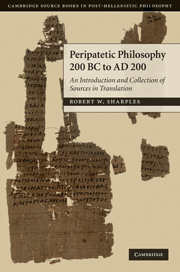Book contents
- Frontmatter
- Contents
- Preface
- Abbreviations
- Introduction
- Individuals
- Chapter 1 People
- Chapter 2 The rediscovery of Aristotle’s works?
- Chapter 3 A Hellenistic account of Aristotle’s philosophy
- Chapter 4 Philosophy and rhetoric
- Chapter 5 The starting-point and parts of philosophy
- Chapter 6 Commentaries
- Logic and ontology
- Ethics
- Physics
- Bibliography
- Index of sources
- Index of passages cited
- Index of personal names (ancient)
- General index
Chapter 5 - The starting-point and parts of philosophy
Published online by Cambridge University Press: 05 June 2012
- Frontmatter
- Contents
- Preface
- Abbreviations
- Introduction
- Individuals
- Chapter 1 People
- Chapter 2 The rediscovery of Aristotle’s works?
- Chapter 3 A Hellenistic account of Aristotle’s philosophy
- Chapter 4 Philosophy and rhetoric
- Chapter 5 The starting-point and parts of philosophy
- Chapter 6 Commentaries
- Logic and ontology
- Ethics
- Physics
- Bibliography
- Index of sources
- Index of passages cited
- Index of personal names (ancient)
- General index
Summary
Philoponus, On Aristotle’s Categories 5.15–20
Next is the third heading, where in Aristotle’s writings one should start. Well, Boethus of Sidon says that one should start from the treatment of physics, since this is more familiar and knowable for us, and one should start from the things that are more clear and knowable. But his teacher, Andronicus of Rhodes, examining [the issue] more exactly, said that one should first begin with logic, which is concerned with demonstration.
Elias, On Aristotle’s Categories 117.17–25
Let us investigate three things, where to start on Aristotle’s writings, where to end, and the route between. We make this investigation not only because of the number of [the writings] but also because of the disagreement among the ancients; for some said that one should begin with physics, some with logic, others with ethics, others from mathematics. Boethus of Sidon says with physics; Andronicus of Rhodes, the eleventh of the successive heads of the Aristotelian school, said with logic, and of the Platonists some with ethics, others with mathematics.
- Type
- Chapter
- Information
- Peripatetic Philosophy, 200 BC to AD 200An Introduction and Collection of Sources in Translation, pp. 40 - 43Publisher: Cambridge University PressPrint publication year: 2010

